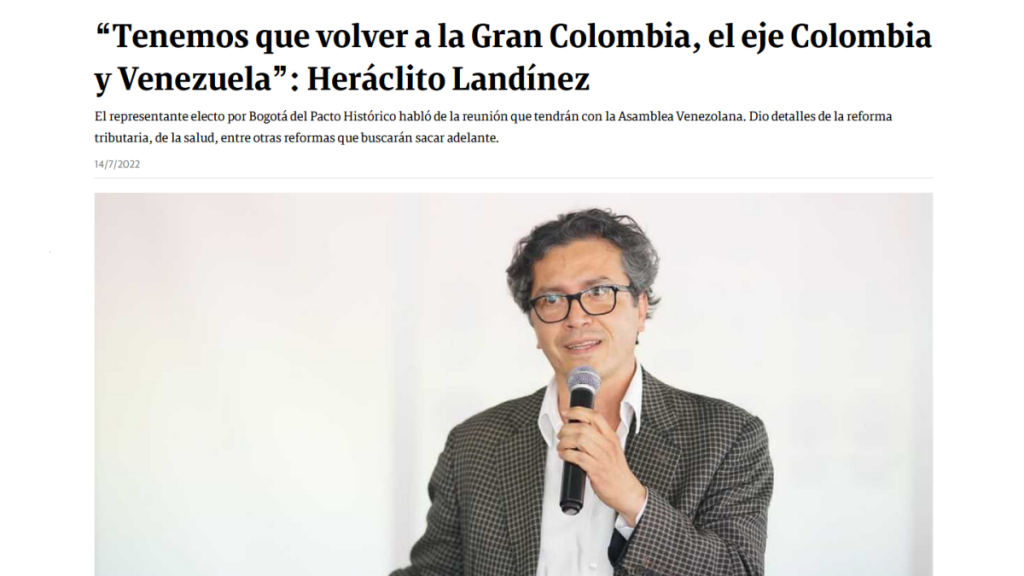Will Colombia finally pacify all its guerilla groups?
The National Liberation Army (Ejército de Liberación — ELN) is now ready to commence peace talks with the new government of Colombian President Gustavo Petro.
Colombia’s 34th President, who himself was a member of the M-19 guerilla movement, made reaching a peace agreement with rebel groups such as the ELN an integral part of his campaign platform.
The president issued statements in separate interviews calling for a ceasefire with groups such as the ELN. Petro stressed that these ceasefires be conducted in a “bilateral” fashion.
Petro’s proposal is one for “total peace” in order to end the prolonged guerilla war that has taken place in Colombia starting in 1964.
Initially, the ELN put out a statement announcing its willingness to engage with the Colombian government to establish a lasting peace. Though there are some catches to the peace process. The ELN ultimately wants the peace process to be crafted on their own terms.
Namely, they want the government to sufficiently address sensitive questions such as the country’s economic model, crop substitution, and political participation. If the government fails to do so, the ELN will not move forward with the peace process.
Historically speaking, peace talks have fallen through between rebel groups such as the ELN and the Colombian government. Numerous sticking points such as the lack of guarantees, the death of key political figures, and attacks on key economic infrastructure, have scuttled negotiations between the two parties starting in the 1970s.
Establishing peace in Colombia would go a long way towards stabilizing the political situation in Colombia, thereby further making it an attractive option for foreign investors. The peace process may also form part of a broader effort to re-establish Gran Colombia — a state that encompassed modern-day Colombia, Panama, and Venezuela along with large parts of Ecuador.
Petro has signaled his willingness to engage its controversial neighbor in Venezuela after his government restored diplomatic relations with the oil-producing giant. Back in 2019, Colombia formally broke diplomatic ties with Venezuela over its highly disputed presidential election.
With Colombia potentially settling its guerilla struggle and normalizing its relations with Venezuela, a Gran Colombia project could potentially be on deck. Specifically, one that aligns with US interests. For decades, Colombia has been one of the US’s most reliable allies in Latin America. Colombia’s right-wing governments under Alvaro Uribe and Juan Manuel Santos have already shown a willingness to play ball with DC. However, with Petro’s victory many conservative Latin America experts had palpable fears of Colombia potentially drifting towards the “troika of tyranny” — Cuba, Nicaragua, and Venezuela.
Despite Petro’s government being ostensibly on the progressive Left, the type of leftism that it espouses tends to be more of the cultural leftist variety that jives well with the Collective West’s globalist agenda. As a result, Colombia could form part of the progressive bloc of countries such as Argentina and Chile that could serve as an alternative to the Bolivarian axis.
Gran Colombia projects aren’t just confined to the US-led order in Latin America. Under the rule of the late-Hugo Chávez, Venezuela pursued a Gran Colombia strategy of sorts that consisted of exercising political influence in the geographic space of the former Gran Colombia. Chávez’s regime sought to back Colombian insurgents such as the FARC and use revenues from the oil boom of the 2000s to buy influence across Latin America. This Gran Colombia project was ostensibly designed to bring Colombia into the Bolivarian network, which would then lead to the other constituent republics of Ecuador and Panama following suit to create a Gran Colombia 2.0.
In turn, this Bolivarian network would subsequently forge alliances with rising powers such as Russia and China. In entering alliances with these Eurasian nuclear powers, Venezuela would be well-positioned to reduce US influence across Latin America.
However, with the collapse of Venezuela’s economy in the last ten years and its alarming levels of inflation, the Venezuelan-style Gran Colombia project has largely remained a distant dream for the petrostate.
All things considered, the Colombian-centric version of Gran Colombia seems like the more viable of the projects. Colombia is already a relatively successful Latin American nation that is a reliable ally of the US.
A supranational governing body has long eluded Latin America. However, a 21st century Gran Colombia project with Colombia at the center could stir things up. The normalization of relations between Colombia and Venezuela is a first step towards increasing cooperation between the two nations.
From there, Washington elites may perhaps opt for a softer power, color revolution approach to dealing with Venezuela. The end goal here would consist of toppling the current Chavista ruling class in Venezuela.
In effecting such a regime change maneuver, Venezuela will likely have a much more Washington-friendly and pliant government that will go along with a neoliberal-style Gran Colombia venture.
This would be a vehicle for the US to push for greater integration among Latin American countries thereby bringing the Western Hemisphere closer towards a transcontinental governing body.
As quixotic as such a project would sound, many North American elites believe in it. If political observers have learned one thing about globalists, it’s that they’re a persistent group of people who look for every opportunity to advance their post-national agenda.
